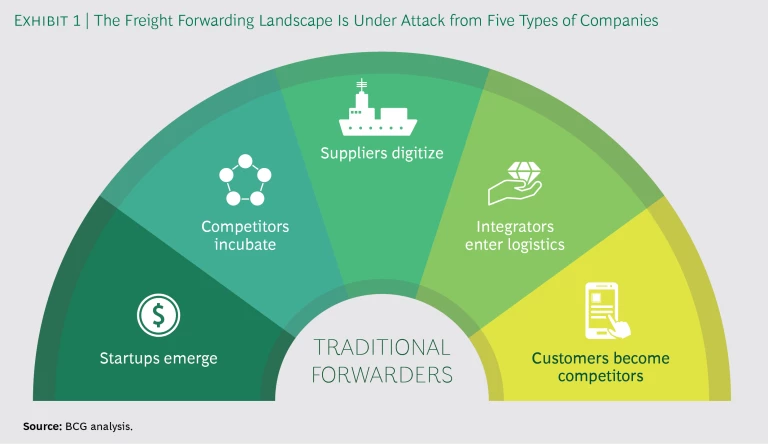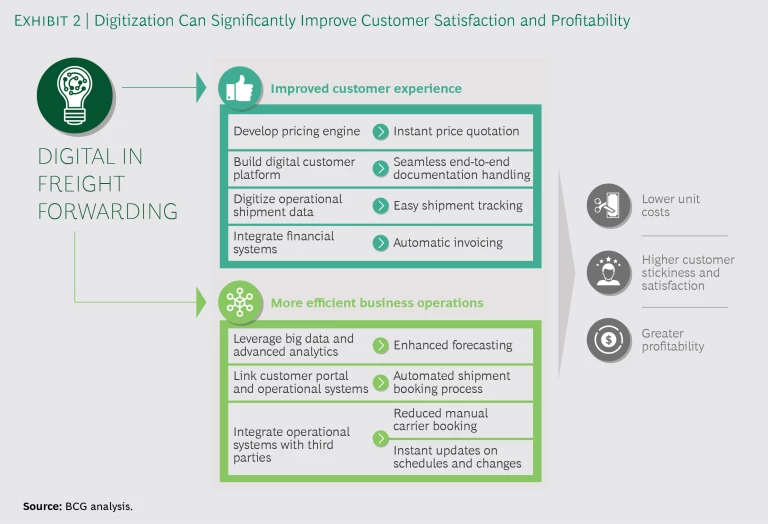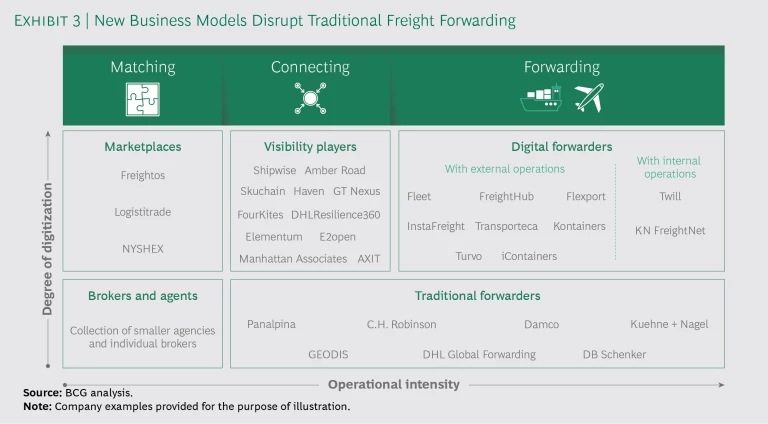A wave of digital disruption is about to hit sea and air freight forwarders. Startups, suppliers, and even customers are using digital technologies to develop a variety of innovative business models that will dramatically improve the customer experience and eliminate entrenched operational inefficiencies. These digital business models have the potential to overturn the dominant position traditional forwarders have long held in the industry.
Traditional forwarders that wish to survive have no choice but to digitize. By our estimate, automating manual processes now could reduce certain back-office and operations costs by up to 40%, while digitizing significant parts of the sales process could reduce related direct costs even more. And as the new business models gain traction over the long term, digital capabilities will open up tremendous opportunities to win in the marketplace.
As the new business models gain traction over the long term, digital capabilities will open up tremendous opportunities to win in the marketplace.
What’s Driving the Digital Rush
Two major issues have long challenged the air and sea freight-forwarding industry, and provided impetus for new entrants.
Lackluster Customer Experience. The traditional offline quotation and booking process is lengthy and cumbersome, often necessitating several interactions to reach a final price. A shipper who asks a forwarder for a quote can wait as long as 100 hours, according to a recent study by Freightos. Filling out and checking shipping documents can be tedious and time consuming. And it is difficult to track shipping orders in real time, so when exceptions occur, customers don’t have a chance to make the decisions needed to ensure their cargo will arrive according to plan.
The traditional offline quotation and booking process is lengthy and cumbersome, often necessitating several interactions to reach a final price.
Manual Processes. Compared with other industries, an unusually high number of manual processes is the norm in air and sea freight forwarding. Some companies still rely on email, personal handoffs, and even faxes to convey shipping docments—all time-consuming and error-prone methods that jack up costs and squelch profits. The Freightos study found that only 5 out of the top 20 forwarders send automated confirmation emails and even fewer provide instant quotations. Costs to serve are especially high for companies with a large number of transactional customers. (See The Digital Imperative in Container Shipping , BCG Focus, February 2018.)
Disruption on Many Fronts
Eager to seize the opportunity, many companies have entered the digital fray. Five types of companies pose a threat to traditional forwarders (see Exhibit 1):
- Startups such as Freightos and Flexport developed digital business models that streamline the customer experience and provide greater visibility into the supply chain.
- Competitors such as Kuehne + Nagel and Maersk-Damco are digitizing their go-to-market approach, incubating new business models to revamp the customer experience, improve profitability, and drive new growth.
- Suppliers such as Maersk, with its portal, my.Maerskline.com, are digitizing their booking processes to significantly reduce the time needed to complete a container booking. Increasingly, carriers are trying to sell directly to shippers and bypass forwarders altogether.
- Integrators such as FedEx (including its TNT Express subsidiary) and UPS are increasingly expanding their activities in logistics by leveraging their end-to-end IT systems.
- Customers with strong technology capabilities who are eager to gain control of the complete online customer experience are entering the race. Amazon, for example, is set up well to move into air and ocean freight forwarding.
As these companies clearly realize, applying digital technologies to the front and back ends of operations offers many opportunities to improve both the customer experience and operations. Digitization of processes from booking to documentation handling can bring tangible benefits to customers and logistics service providers alike. (See Exhibit 2.)
These opportunities are all the more attractive given the fragmented nature of the industry. No single player dominates: the largest player in freight forwarding, DHL, had a market share of only 13% in 2017. The top five companies account for less than 50% of the more than $130 billion sea and air freight-forwarding market, while a vast amount of small, local freight forwarders occupy the rest.
No single player dominates: the largest player in freight forwarding, DHL, had a market share of only 13% in 2017.
Capital Follows Opportunity
Not surprisingly, venture capitalists find the sector highly attractive. They poured more than $3.3 billion into digital shipping and logistics startups from 2012 to 2017. A considerable portion of this funding went to freight forwarding.
The most prominent example is Flexport, a San Francisco-based digital freight forwarder and logistics platform. Founded in 2013, the company has about half of its business in ocean freight and the other half in air freight. After its Series C round of funding in September 2017, Flexport had a valuation of $800 million. DST Global led this round; other investors include Founders Fund and Wells Fargo. In 2018, the company received $100 million from SF Express, a leading courier company in China. This brought Flexport’s total funding to $300 million and its valuation to more than $1 billion. The startup has a run-rate revenue of approximately $400 million and is currently growing threefold year over year. It ships roughly 120,000 TEUs (20-foot equivalent units) annually, with a focus on transpacific trade lanes, where its shipment volume is the 20th largest on the transpacific eastbound route.
Other examples include (see Exhibit 3):
- Freightos, founded in 2012: total funding of $93 million and a valuation of well over $100 million; latest funding round Series C; key investors include GE Ventures, ICV Partners, Aleph, and Singapore Exchange
- FreightHub, founded in 2016: total funding of $23 million; latest funding round Series A; key investors include Northzone Ventures, Global Founders Capital, and Cherry Ventures
- Fleet, founded in 2014: total funding of $14 million and a valuation of $32 million; latest funding round Series A; key investors include Lufthansa Cargo, UPS, and Avala Capital
- Haven, founded in 2014: total funding of $14 million; latest funding round Series A; key investors include Spark Capital, Sway Ventures, and O’Reilly AlphaTech Ventures
- IContainers, founded in 2007: total funding of $11 million; latest funding round Series C; key investors include Serena Capital, Kibo Ventures, and Viriditas Ventures
In addition, startups such as NYSHEX and Cogoport have entered the space recently. Meanwhile, other startups are dropping out of the market. Frachtraum is a recent example of a freight forwarder ceasing operations.
Innovative Digital Business Models Could Alter the Landscape
The new players have introduced a variety of innovative business models that together have the potential to shake up the industry. We focused on the models likely to have the most impact and classified the relevant companies according to how digitized and operationalized their core capabilities are. These companies offer three main types of service.
The new players have introduced a variety of innovative business models that together have the potential to shake up the industry.
Matching Demand with Supply. Digital marketplaces provide platforms that shippers in search of cargo space can use to find capacity providers such as carriers and freight forwarders. This can also include platforms offering private forward contracts for shipping capacity, such as NYSHEX. Freightos is an example of an international freight marketplace that gives instant freight quotes and enables customers to book capacity online immediately at a given rate.
Connectivity Through Platforms. These companies provide software and services that consolidate and integrate information across the supply chain. For shippers, that translates to end-to-end visibility on a single platform. Manhattan Associates and GT Nexus both operate cloud-based platforms that enable companies to automate trade and logistics processes with their supply chain partners. Elementum and E2open provide control-tower solutions.
Forwarding Freight Digitally. As their moniker implies, digital freight forwarders (DFFs) use a digital platform to offer a broader range of logistics services than marketplaces and connectivity providers. DFFs build their core value proposition around a seamless user experience of shipping goods from one point to another while aggregating information on one platform with a single user interface. At the same time, DFFs are able to replace manual processes and paperwork with instant price quotations, simple and standardized document management, a streamlined communication process, and easy access to live data that can be used to track shipments.
Two distinct models are emerging in the DFF space. In the first, the company has extensive operational capabilities in-house; in the second, it relies on partners for operations:
- Digital Forwarders with External Operations. Companies in this category tend to contract with local agencies and forwarding service providers that have operational know-how and physical assets. The lack of internal operational capabilities allows DFFs to avoid operational complexity and its attendant costs, though it also means forgoing direct control over exception handling and service consistency. Furthermore, it’s harder to standardize and streamline processes, which is critical for a scalable business model. Consequently, these types of players focus on simpler shipments and rather transactional customers, for now at least.
An example of a company that started out in this category is Flexport. A user-friendly platform, it books directly with carriers and contracts with local forwarders to provide land-side coverage. Flexport claims its online platform eliminates the transaction costs of email and phone communications while giving customers more visibility into and control over their supply chains. Recently, the company began establishing internal operations in the US and Europe. In addition, it forged a strategic partnership with SF Express, which could signal interest in setting up operations in Asia as well.
- Digital Forwarders with Internal Operations. These companies tend to offer a more comprehensive set of services than their less operationally intensive counterparts. They provide larger geographical coverage, more methods of transport, and local customer service. They are able to launch and scale their activities more quickly because they can leverage their existing footprints and customer relationships. But like DFFs with external operations, they face the challenge of scaling automation throughout their back-end operations—a cumbersome task that requires major changes to existing processes.
These types of players are usually created by an incumbent pursuing a digital strategy. Twill, for example, is the brainchild of Damco, Maersk’s freight-forwarding business . Launched in 2017, Twill has grown quickly, with outposts in more than ten countries, including the US, UK, Germany, India, and China. The startup recently changed its brand affiliation from Damco to Maersk—a clear reflection of Twill’s importance to Maersk’s goal of becoming the global integrator of container logistics.
Freight Forwarding’s Likely Future
As these new digital business models gain traction, the freight forwarding landscape will likely undergo significant changes.
Legacy brokers will fade away. No longer able to provide any incremental value, they will likely soon be left out of the equation altogether unless they transform into DFFs.
Traditional forwarders will digitize. Incumbent digital forwarders are well positioned, with global coverage, transportation in different modalities, and an existing customer base. Some companies have started incorporating advanced analytics, robotics, and digital front ends. But these moves, in themselves, are not enough. Incumbents need to fully digitize their offerings and automate and integrate their back-end operations with third parties.
Digital forwarders will intensify operations. Companies that lack their own operations will either build them organically or partner with forwarders that already have them. Flexport does both.
Digital business models will evolve. Anticipating that the marketplace potential of their business models might be limited, some companies will adopt different models. Fleet recently pivoted from a marketplace to a digital forwarder, while Haven moved from a marketplace to a transportation management software provider. Moreover, the boundary between digital forwarding and providing connectivity will blur. Some connectivity players will form partnerships or merge with traditional forwarders. Similarly, DFFs will expand their offerings to connect to other service offerings along the logistics value chain.
Companies will consolidate. M&A activity will pick up, as larger players acquire smaller ones with similar business models. We also expect consolidation across different business models, with traditional forwarders acquiring digital startups. Undoubtedly, the vast majority of the hundreds of startups will not stand alone indefinitely as the market matures. A recent example is E2open’s acquisition of INTTRA.
Metaplatforms might emerge. Over the next five to ten years, DFFs will become well established. This will create an opportunity for what we call metaplatforms, companies that will consolidate multiple DFFs. Metaplatforms will provide more competitive offerings for shippers and consignees, which can lead to the commoditization of DFFs. While some digital marketplaces will continue to exist as they do today, others that are more ambitious will leverage their current positioning in the market to seize the metaplatform opportunity.
Implications for Incumbents
There’s no question that digitization offers tremendous benefits for customers and that traditional freight forwarders will soon have little choice but to go digital. Five actions will be critical.
Traditional freight forwarders will soon have little choice but to go digital.
Digitize the customer experience. Incumbents should immediately start digitizing their customer-facing front ends to provide a better user experience. This includes improving the quotation and booking process and adding functions such as digital documentation handling and shipment data analytics. Both Flexport and Twill’s platforms provide seamless experiences and include dashboards that act as a go-to source for all information
on shipments.
Automate operations. Companies that automate processes for activities such as shipment planning, carrier booking, document handling, and invoicing will see significant improvements in cost to serve and unit economics. The transparency made possible by big data can enable forwarders to stay abreast of changes in vessel availability, schedules, and exceptions in real time.
Digitize support functions. Incumbents that apply digital technologies to their finance and human resources processes will see service levels and efficiency improve considerably. Headcount reductions can yield up to 30% cost savings in finance and up to 20% in HR. Implementing data-driven cash collections and automated reviews of purchase orders can reduce overdue payments, while digitizing hiring and onboarding processes can shorten hiring timelines and ensure that all new hires are ready to work when needed.
Build, partner with, or acquire a digital startup. Companies that decide to build their own startup need to treat it as a startup, not an IT project. That means setting it up as an entity adjacent to the main organization so that it will be free from constraints while attracting and retaining the talent needed for success: innovative thinkers who can make decisions quickly without having to go through lengthy corporate approval processes.
A second option is to partner with a company that has already done this. But this requires integrating the back end of a large corporation with the front end of a startup. This can be more taxing than building digital capabilities from scratch.
A third option is to acquire or invest in a startup. Although this can turn out to be costly because of these players’ high valuations, it can be a worthwhile investment. DB Schenker, for example, is using uShip, an online platform, to connect with trucking subcontractors .
Rejuvenate people and systems. It’s crucial to bring in engineers, experience designers, and product managers with digital capabilities and entrepreneurial mindsets. This can be challenging for large corporations that lack the kind of environment that appeals to such individuals.
Companies also need to change their ways of working to react faster to changing market conditions. An agile approach is preferable because it puts the focus on individuals and interactions instead of set processes and tools. Agile working teams respond to change rather than following a linear plan, and they work with dynamic software rather than comprehensive documentation. It’s essential for incumbents to build such teams outside of the existing organizational structure, where a more flexible environment will allow for faster decision making.
Moreover, IT systems will probably need updating. Large companies often have legacy systems that will require more modern systems such as data lakes.
Clearly, the freight-forwarding industry is about to experience enormous change as new technologies take hold. Incumbents will need to transform significantly to use digital technologies to their advantage. Companies that are innovative and flexible enough to catch this wave will reap the rewards of profitable growth.













